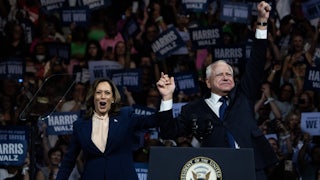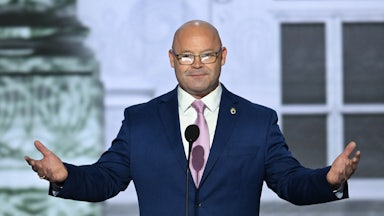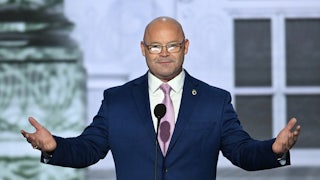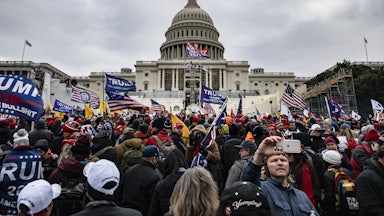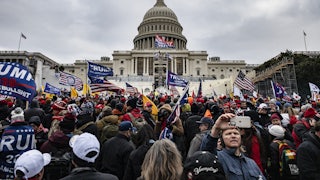The biggest substantive change since candidate Joe Biden stepped aside in favor of candidate Kamala Harris, at least where domestic policy is concerned, is much less discussion of labor unions. As Labor Day approaches, Harris needs to shore up her bona fides. As it happens, Harris herself has already created a plausible blueprint for organized labor’s path forward. With the hard work done, all she needs to do now is talk about it.
“I’m proud to have been the first president to walk a picket line,” President Biden said at last week’s Democratic convention, “and be labeled the most pro-union president in history.” Biden is not the most pro-union president in history, but he’s easily the most pro-union president since Harry Truman—and Eric Loomis, a labor historian at the University of Rhode Island, pronounced Biden the most pro-union president since Franklin D. Roosevelt.
Biden’s labor advocacy mostly consisted of bully-pulpit support for the Protecting the Right to Organize bill, otherwise known as the PRO Act, and for individual strikes by Amazon and auto workers. But Biden also appointed an aggressively pro-union general counsel to the National Labor Relations Board, or NLRB; pressured pension funds not to contest union elections; required the hiring of unionized workers on large construction projects; rescued from bankruptcy 200 “multiemployer” pension funds, including the Teamsters’ Central States fund (making Teamsters President Sean O’Brien’s overtures to the GOP especially galling); banned noncompete clauses in employment contracts (until a Texas judge last week blocked it); and expanded overtime eligibility to 4.3 million additional workers.
Loomis takes points off Biden for forcing an end to a rail strike over sick leave. But even there, the Biden administration later stepped in to help secure sick leave for the affected workers.
In his convention speech, Biden said the word “union” four times, prompting the audience to chant, “Union Joe!” In her convention speech, Harris said “union” not even once. She did mention “labor,” but only in pledging to “bring together labor and workers and small-business owners and entrepreneurs and American companies” to basically join hands and sing “Kumbaya.” This sentiment is repeated in Harris’s much-touted economic plan, released right before the convention. There, too, organized labor is otherwise missing in action (though in her speech announcing the plan Harris did allow that “you should be able to join a union if you choose”).
Harris’s only notable nod in the direction of organized labor (and the working class generally) has been her choice of Minnesota Governor Tim Walz as running mate. Walz has a stunningly good labor record as governor, especially in passing last year of a sort of mini–PRO Act, S.F. 3035, which banned captive meetings by management during union drives; required a minimum of six paid sick days for full-time employees; and banned noncompete clauses in employment contracts. But even Walz omitted the words “labor” and “union” from his convention speech.
Look, I get it. Harris and Walz don’t want to scare away rich donors. Harris, a former senator from California, has strong ties to Silicon Valley, where unions are still largely anathema, and Politico’s Catherine Allen reported this weekend that during the ten days after Biden withdrew on July 21 Harris raised $59 million from individuals, 20 percent of it from California, including $242,000 from Google/Alphabet employees, $170,000 from Apple employees, and $81,000 from Facebook/Meta employees. During convention week the Harris campaign raised another $82 million, a figure that includes donations to the state and local Democratic parties (which tend to be from fat cats). Overall, Harris has raised half a billion dollars in a little over one month. Wall Street has come courting; Jonathan Gray, president of the private equity giant Blackstone, reportedly gave $413,000 to a Harris PAC.
But don’t let’s forget what all that money is for. It’s to harvest votes, and, as I may have pointed out once or twice before, no Democrat has ever won the White House without a working-class majority, going back 100 years. There is one exception: Joe Biden in 2020. But that occurred under the unusual circumstance of his opponent visibly mismanaging a deadly epidemic (a fiasco that the voting public, sadly, no longer seems to remember). As I’ve further pointed out, unions are more popular today (with approval levels of 67 to 68 percent) than at any time since the 1960s. Even affluent suburban voters support a more leftist economic agenda than anything we’ve heard from Harris.
I mentioned that Harris created a useful blueprint on labor issues. That was the February 2022 report of the White House Task Force on Worker Organizing and Empowerment, of which Harris was chair (and Biden’s disappointing first labor secretary, Marty Walsh, vice chair). The report doesn’t say that workers should join labor unions if they happen to feel like it. Rather, it says that “increasing worker organizing and empowerment is critical to growing the middle class, building an economy that puts workers first, and strengthening our democracy.” The report points out that the preamble to the 1935 National Labor Relations Act, which created the NLRB, does not pronounce the federal government neutral on the question of collective bargaining, but rather says the federal government should encourage collective bargaining. The report explicitly directs not only the NLRB but also the lesser-known Federal Mediation and Conciliation Service, the National Medication Board, and the Federal Labor Relations Authority, to do just that.
Here are some policy highlights from the report, all of which I’d like to hear Harris repeat:
Pass the PRO Act, “which would rebuild workers’ organizing and bargaining rights in the private sector after decades of erosion” and “curb the anti-union, anti-worker excesses of the Taft-Hartley Act enacted in 1947.” This is by far the most important point, and Harris should say it at every appearance. (More on the PRO Act here.)
Pass the Public Service Freedom to Negotiate Act, which would “expand public-sector worker collective bargaining rights for state and local government employees.” These rights were dealt a heavy blow by the Supreme Court’s 2018 Janus decision, which eliminated “fair-share fees” charged to nonmembers of public employee unions to cover their share of collective bargaining costs, saddling these unions with a costly free-rider problem.
Extend the National Labor Relations Act (NLRA) to domestic and agricultural workers. Even the existing paltry labor protections available under the NLRA (as amended by Taft-Hartley in 1947) are unavailable to these marginalized workers. In the 1960s Cesar Chavez, president of the United Farm Workers, found a clever way to turn this to his advantage with a grape boycott that would have been illegal had the NLRA covered farmworkers. But Chavez recognized that NLRA coverage was better, and he worked with then-Governor Jerry Brown to create a state-level equivalent for agricultural workers.
Make the tax code pro-labor. One possibility is to make union dues eligible for a tax credit or above-the-line deduction. Another would be to deny employers deductions for union-busting activities.
Prevent worker misclassification. This refers to the sketchy practice of treating workers as independent contractors when for all practical purposes they are employees. Doing so relieves employers of having to pay minimum wage, payroll tax, and other benefits. Legislation would be helpful, but much can be achieved through more rigorous enforcement of existing laws.
The 2022 report contains other useful proposals, many of them using the federal government’s purchasing power to promote unionization. In addition, as I argued last week, Harris should talk up the Federal Trade Commission’s ban on noncompete clauses in employment contracts, which a federal judge recently blocked. It’s a letter-perfect example of the Democrats’ new mantra that they, and not the GOP, are the party of freedom. Just as women should be free to decide whether to carry a pregnancy to term, men and women should be free to work wherever they choose.
None of these policy options are unknown to Harris. Obviously, the chair of the Task Force on Worker Organizing and Empowerment doesn’t write the report, but she almost certainly has read it. Madame Vice President: You’ve done a splendid job persuading Democrats not to be fearful of your opponent, but rather to embrace a more joyful (and less weird) vision of government. Please don’t let linger any fear of labor’s enemies among the donor class. You have a record on organized labor, and in large part the task force report is it. Don’t let that be a secret.


